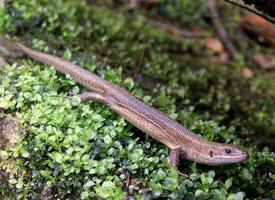
Weights and measures
| Length | from 20 to 25 cm |
|---|
Biological data
| Lifespan | from 1,5 to 2 years |
|---|
State of endangerment
| Endangered |
Animal description
The Sand Lizard (Lacerta agilis) is a fascinating reptile species native to a wide range across Europe and parts of Asia. This species is particularly known for its distinctive physical appearance and behavior, making it a subject of interest among herpetologists and nature enthusiasts alike.Physically, the Sand Lizard exhibits a robust and agile body structure, which is highly adaptive for its terrestrial lifestyle. Males and females display sexual dimorphism, particularly noticeable during the breeding season. Males flaunt strikingly vibrant green flanks, which can vary in shade from bright emerald to a darker green, depending on geographical location and individual genetics. This vivid coloration is contrasted by dark spots and stripes that adorn their backs and sides, serving as an impressive display during mating rituals. Females, on the other hand, tend to have more subdued colorations, ranging from brown to greenish hues, with a pattern of dark spots and stripes that provide camouflage against the sandy and grassy habitats they frequent.
The Sand Lizard's body is covered in small, granular scales, with larger, keeled scales running down the middle of the back, providing texture and further aiding in camouflage. Its head is relatively large with strong jaw muscles, accommodating a diet primarily consisting of insects, spiders, and occasionally plant material. The tail, which can be twice the length of its body, serves multiple purposes: it aids in balance and agility, and it can be detached to escape predators in a remarkable survival tactic known as autotomy.
Sand Lizards prefer habitats that offer both sandy soils for burrowing and dense vegetation for cover. They are commonly found in heathlands, dunes, and forest edges. Their preference for sun-drenched locales is tied to their ectothermic nature, requiring them to bask in the sun to regulate their body temperature. Despite their preference for warmth, Sand Lizards are adept at surviving cooler climates than many other lizard species, owing to their ability to hibernate during the winter months. They burrow into the ground or find refuge in deep leaf litter to escape the cold.
Breeding season brings a flurry of activity, typically occurring in late spring to early summer. After a series of elaborate courtship displays, females lay eggs in warm, sandy soils where they incubate for several weeks before hatching. The young are independent from birth, possessing the same cryptic coloration as adult females to help them evade predators.
Despite their adaptability, Sand Lizards face threats from habitat loss and fragmentation, primarily due to agricultural expansion, urban development, and forestry practices. They are also vulnerable to predation by domestic animals and road mortality. Conservation efforts are in place in several countries to protect their habitats and ensure the survival of this species. Measures include habitat restoration, legal protection, and research to better understand their ecological needs.
The Sand Lizard is not just a creature of beauty and fascination but also an important part of the ecosystem, serving as both predator and prey. Its presence indicates a healthy, biodiverse habitat. Through continued conservation efforts, it is hoped that this remarkable species will continue to thrive across its natural range for generations to come.
Similar Animals
New photos of animals
Top 10 animals
- Dolphin gull (Leucophaeus scoresbii)
- Diana monkey (Cercopithecus diana)
- Moustached guenon (Cercopithecus cephus)
- Galápagos tortoise (Geochelone nigra complex)
- Stone loach (Barbatula barbatula)
- Greek tortoise (Testudo graeca)
- Japanese macaque (Macaca fuscata)
- Russian tortoise (Testudo horsfieldii)
- Common flying dragon (Draco volans)
- Galápagos penguin (Spheniscus mendiculus)


